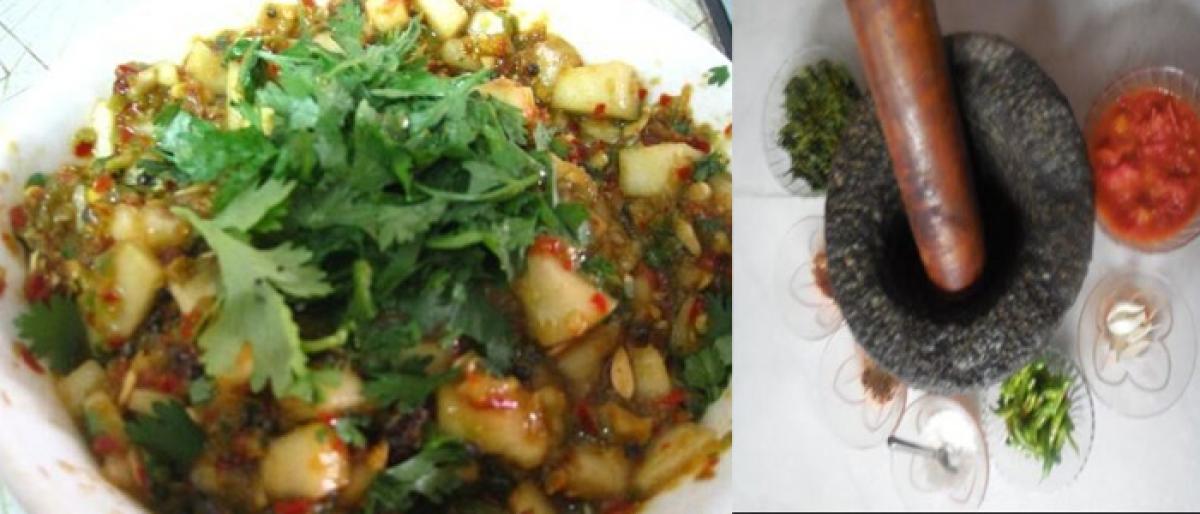Live
- Regional rural banks must empower MSMEs via flagship govt schemes: FM Sitharaman
- Jemimah Rodrigues credits backing from Brisbane Heat teammates for classy 61-run knock
- Stalin in Virudhunagar district as part of statewide tour to monitor govt schemes
- BJP's politics of development immensely benefitted Muslims in last 10 years: Sarbananda Sonowal
- BRIC to drive research synergy, transform power of science, tech & innovation: Centre
- Train services remain disrupted in some NE states due to railway track damage
- ISL 2024-25: Chennaiyin FC, Mumbai City share spoils in milestone 1000th league game
- Keshav Chandra takes oath as NDMC chairman
- India's coal production from captive, commercial mines crosses 100 MT
- J&K: Tearful adieu for slain VDC members in Kishtwar
Just In

All of India, especially the south of sub-continent, more or less shares a commonality in the type of dishes. Names may vary, ingredients may be different – but surely there is a similarity that binds us, yet a unique feature that keeps the diversity intact.
All of India, especially the south of sub-continent, more or less shares a commonality in the type of dishes. Names may vary, ingredients may be different – but surely there is a similarity that binds us, yet a unique feature that keeps the diversity intact.
Take ‘Roti Pachallu’ – the quick chutneys – for instance. Every state has its own version of these chutneys made in a unique method and consumed differently. Quoting a senior journalist and publisher of a book – ‘Noroorinche Nooruruchulu Roti Pachallu’ that when roughly translated means 100 mouthwatering tastes – Chutneys made using mortar and pestle: Vasireddy Venugopal, “Each Roti Pachchadi is different in taste based on the ingredients, the order of ingredients used and the way they have been used, and also on the hand that grinds the ingredients.”
He can’t be more right. As an introduction to his book, which followed the numerous Facebook posts where he personally sat before the rolu (pestle made of granite) and showcased delightful pachadis – he says – Cooking is a combination of Art and Science.
The science surely starts with the pestle. For convenience and time saving we do tend to use the electric mixer to make a pachadi. However, the coarsely ground ingredients mixed in the right proportions in a rolu surely give a different taste to the dish. Take for example a Dosakaya Pachadi. One method of doing it is roasting the green chillies in oil with a little seasoning, pounding them well along with some tamarind soaked in water, and then adding dosakaya cut into small pieces.
The secret to this delicious pachadi is to ensure the pieces are not crushed completely. Flavouring it with curry leaves and coriander and having it with steaming hot boiled rice is heavenly on the palate and brings memories of childhood when food translated to mother’s touch. In later years I learnt another version where brinjal and tomato, one each are roasted, and this too went into the rolu before the Dosakaya pieces, and out came this pachadi which is gravy-like, hence went extremely well with the must made festive preparation garelu (the Andhra styled Vada)
In fact, not very long ago, most homes had one mandatory rolu – a big one to make the batter for Idli or Gare (vada), and a smaller one kept on the kitchen platform. Eventually, with shrinking spaces, the bigger rolu found its way out and the smaller rolu was somehow retained if only to use it to crush one random piece of ginger or garlic. The taste and texture of a Gare when the batter is ground in a rolu vis a vis an electric mixer was so evident that many home appliance companies have come up with an automated imitation of the traditional rolu.
However, no replacement can be found for an electric appliance to make the Roti Pachadi, because it is a combination of crushing and pounding, which too follows a specific process, and one sure miss would be the magical hand that plays a major role in bringing the taste.
Roti Pachallu is simple, sometimes as basic as putting in raw green chillies, some garlic pods, a pinch of salt, wee bit zeera, and a tiny portion of tamarind and pound well. The three Telugu regions boast of hundreds of variations of these mouthwatering preparations, and yes you do have an option to use your friendly electric mixer…and it would still be tasty, however, minus the magical touch.

© 2024 Hyderabad Media House Limited/The Hans India. All rights reserved. Powered by hocalwire.com







